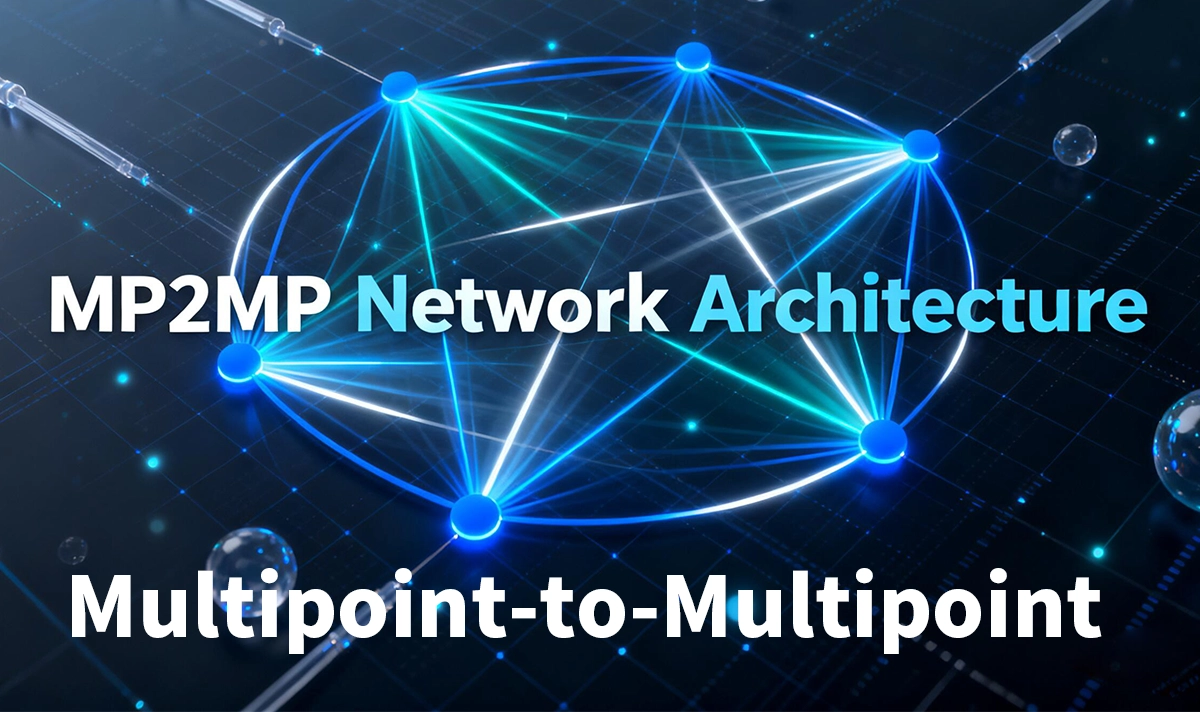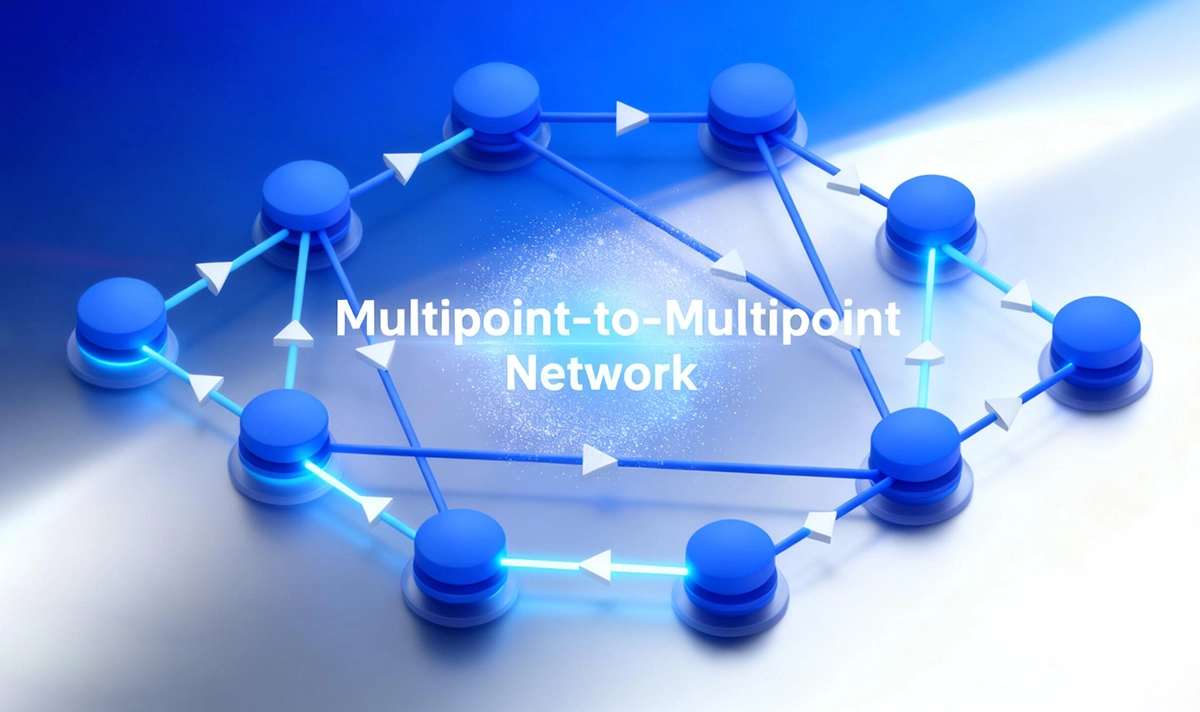
🔹 MP2MP Network Architecture Overview
▲ What is MP2MP?
Multipoint-to-Multipoint (MP2MP) is a communication topology where multiple nodes can both send and receive data to and from multiple other nodes within the same network. Unlike Point-to-Multipoint (P2MP), which features a central hub communicating with multiple end nodes, MP2MP provides a fully meshed logical connection, enabling dynamic, distributed communication.
MP2MP architectures are particularly suited to environments that require real-time coordination, such as data center interconnects, industrial IoT, and advanced optical metro networks.
▲ Comparison with P2P and P2MP
P2P (Point-to-Point): One-to-one connection between two devices.
P2MP (Point-to-Multipoint): One-to-many transmission from a single root node.
MP2MP (Multipoint-to-Multipoint): Many-to-many communication where all nodes are peers, each capable of transmitting and receiving independently.
In optical networking, MP2MP provides higher flexibility and resilience, enabling simultaneous communication across distributed nodes.
🔹 Working Principle of MP2MP Networks
1. Core Architecture
MP2MP networks establish logical links between multiple optical nodes, enabling bidirectional data exchange without centralized control. Each node can act as both a transmitter and receiver, dynamically managing its traffic through routing or switching protocols.
Optically, this can be implemented using Wavelength-Division Multiplexing (WDM), Reconfigurable Optical Add-Drop Multiplexers (ROADMs), or Software-Defined Networking (SDN)-controlled switches to manage connections between nodes.
2. Control and Data Flow
In a typical MP2MP configuration:
Every node maintains routing knowledge of others within the domain.
Control messages synchronize link states, bandwidth allocation, and optical path management.
Data traffic is transmitted directly between nodes, optimizing latency and redundancy.
3. Standards and Protocols
MPLS MP2MP LSPs are defined by the IETF (RFC 6388) for multipoint label-switched paths.
Optical Transport Network (OTN) with multi-node interconnection capabilities.
Ethernet multipoint bridging (IEEE 802.1Q) for Layer 2 multipoint communication.

🔹 Optical Implementation in MP2MP Systems
Key Technologies
WDM (Wavelength Division Multiplexing): Assigns wavelengths to separate logical connections between nodes.
ROADMs: Enable flexible reconfiguration of optical paths between any set of endpoints.
SDN Integration: Centralized control with distributed intelligence ensures path optimization and resilience.
Technical Parameters
Wavelength channels per link: up to 96 or more for dense WDM systems.
Optical power budget and attenuation control across all nodes.
Reconfigurable mesh topology for dynamic traffic demands.
Low-latency switching for data-intensive applications such as AI clusters and HPC systems.
Example Scenario
In a metropolitan optical ring, MP2MP enables multiple data centers and access nodes to communicate in real-time, improving fault tolerance and network utilization compared with traditional hub-spoke models.
🔹 Applications of MP2MP Networks
★ Data Center Interconnection (DCI)
MP2MP enables peer-to-peer data exchange among data centers for redundancy, load balancing, and cloud synchronization.
★ Optical Metro Networks
Supports dynamic traffic between aggregation points and edge nodes, improving efficiency and network adaptability.
★ Industrial and IoT Systems
In distributed control networks, MP2MP allows real-time feedback and coordination among sensors, controllers, and monitoring stations.
★ 5G / 6G Fronthaul and Backhaul
MP2MP topologies facilitate multi-cell cooperation and centralized processing, enhancing bandwidth sharing and ultra-low-latency communication.
🔹 Advantages and Challenges
▶ Advantages
High flexibility: Any node can communicate with any other node.
Resilience: No single point of failure; traffic can be rerouted automatically.
Optimized bandwidth: Dynamic allocation across multiple optical paths.
Scalability: Supports expansion without major topology redesign.
▶ Challenges
Complex management: Requires sophisticated routing and synchronization mechanisms.
Optical budget balancing: Multiple branches increase signal attenuation.
Higher CAPEX for initial setup: ROADMs and WDM multiplexers add cost.
Power and wavelength coordination: Demands intelligent control for interference-free operation.
🔹 Optical Transceiver Role in MP2MP Topologies
Selecting the Right Modules
Optical transceivers enable high-speed, low-latency transmission between MP2MP nodes. Each node’s transceiver must support multi-channel operation and adaptive power control to maintain signal integrity across multiple routes.
LINK-PP Optical Modules for MP2MP

LINK-PP offers a comprehensive portfolio of optical transceivers optimized for MP2MP systems:
SFP / SFP+ / QSFP+ / QSFP28 modules supporting 1G to 400G links
Single-mode and multi-mode options for flexible deployment
DOM (Digital Optical Monitoring) for real-time performance tracking
Hot-pluggable and vendor-compatible design ensuring interoperability
For instance, LINK-PP’s SFP+ LR and QSFP28 LR4 modules are ideal for multi-node metro or data center interconnects, providing long-reach, high-bandwidth connectivity suitable for MP2MP applications.
Key Considerations
Match link distance and optical budget
Choose appropriate wavelength bands for WDM
Ensure transceivers support monitoring for multi-node maintenance
Verify compatibility with network control protocols
🔹 Design and Deployment Considerations
1. Network Topology Design
A well-designed MP2MP network minimizes path redundancy while maximizing resilience. Hybrid topologies combining ring and mesh structures are common in metro networks.
2. Wavelength and Power Planning
Accurate wavelength management ensures non-interfering transmission between multiple nodes. Automatic power equalization prevents signal degradation.
3. Reliability and Maintenance
Optical modules with monitoring and hot-swap capabilities allow quick fault isolation and replacement without affecting the entire network.
4. SDN-Orchestrated MP2MP
Combining MP2MP optical hardware with SDN controllers allows dynamic provisioning, automated rerouting, and predictive maintenance — essential for next-generation, AI-driven networks.
🔹 Summary
MP2MP networks support many-to-many optical communication with distributed intelligence.
They deliver resilience, scalability, and flexibility, making them ideal for next-generation optical networks.
Successful deployment requires precise optical budget management, transceiver compatibility, and SDN-based orchestration.
LINK-PP optical modules provide the performance and reliability necessary to enable seamless MP2MP connectivity across modern communication infrastructures.
🔹 MP2MP Optical Network – FAQ
Q1: What does MP2MP stand for?
A: MP2MP stands for Multipoint-to-Multipoint, a network architecture where multiple nodes communicate directly with each other. Unlike Point-to-Multipoint (P2MP), there is no central controller—each node can send and receive data from multiple peers simultaneously.
Q2: How does MP2MP differ from P2MP?
A: In a P2MP topology, one central node distributes data to multiple endpoints, following a unidirectional data flow. MP2MP, on the other hand, enables full-duplex communication among all nodes, making it ideal for decentralized, collaborative, or distributed processing systems.
Q3: What are the typical applications of MP2MP networks?
A: MP2MP architectures are widely used in optical transport networks (OTN), data center interconnects, industrial IoT frameworks, and carrier-grade Ethernet systems where low latency and peer-to-peer coordination are required.
Q4: Which LINK-PP products support MP2MP communication?
A: LINK-PP provides a full portfolio of SFP/SFP+ optical transceiver modules, such as the 1G SFP Series, that ensure reliable data exchange across MP2MP environments. These modules offer high interoperability with major OEM platforms and are designed for stable, low-latency optical transmission.
Q5: What are the advantages of MP2MP over traditional topologies?
A:
High scalability – Easily supports additional nodes without redesigning the network.
Resilience – No single point of failure, ensuring continuous communication.
Efficiency – Enables direct peer-to-peer data exchange, minimizing transmission hops and delays.
Flexibility – Supports both synchronous and asynchronous communication models.
Q6: Does MP2MP require specific optical modules or cabling?
A: MP2MP networks typically use multi-fiber links and high-speed optical transceivers (e.g., 1G/10G/25G SFP/SFP+ modules) to sustain bidirectional throughput. LINK-PP’s transceivers are designed for such mesh or distributed systems, offering consistent signal integrity and optical compatibility.


